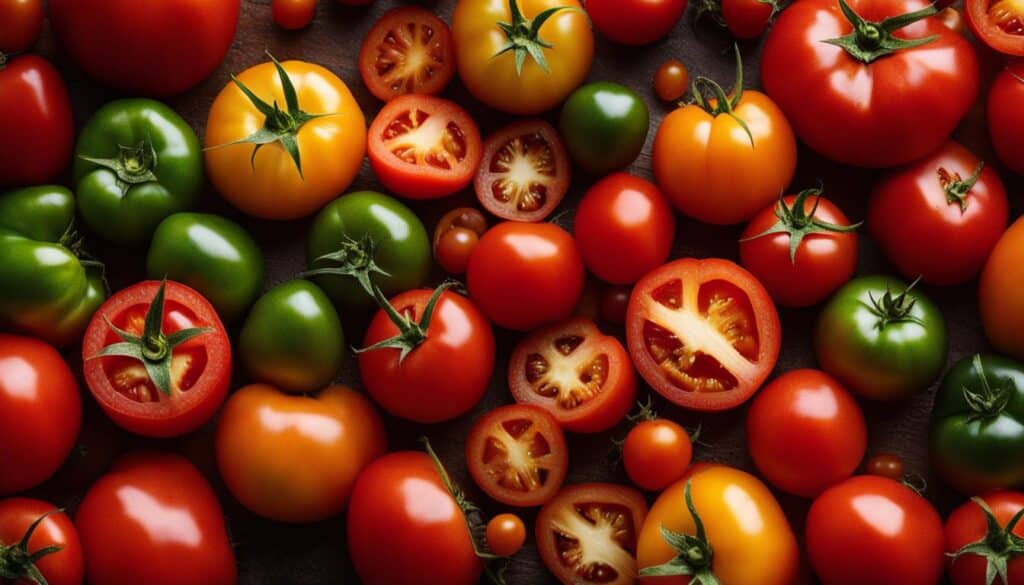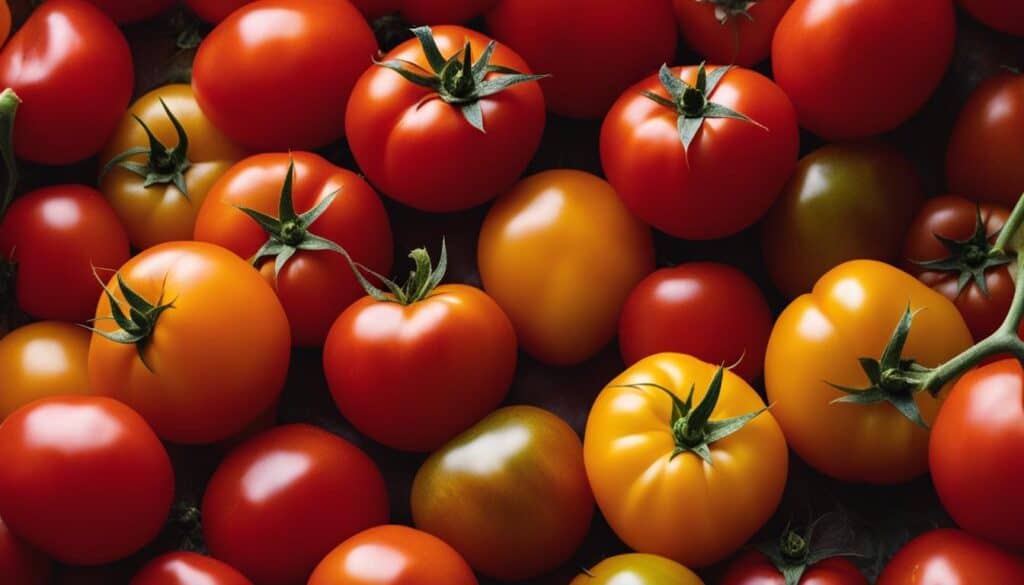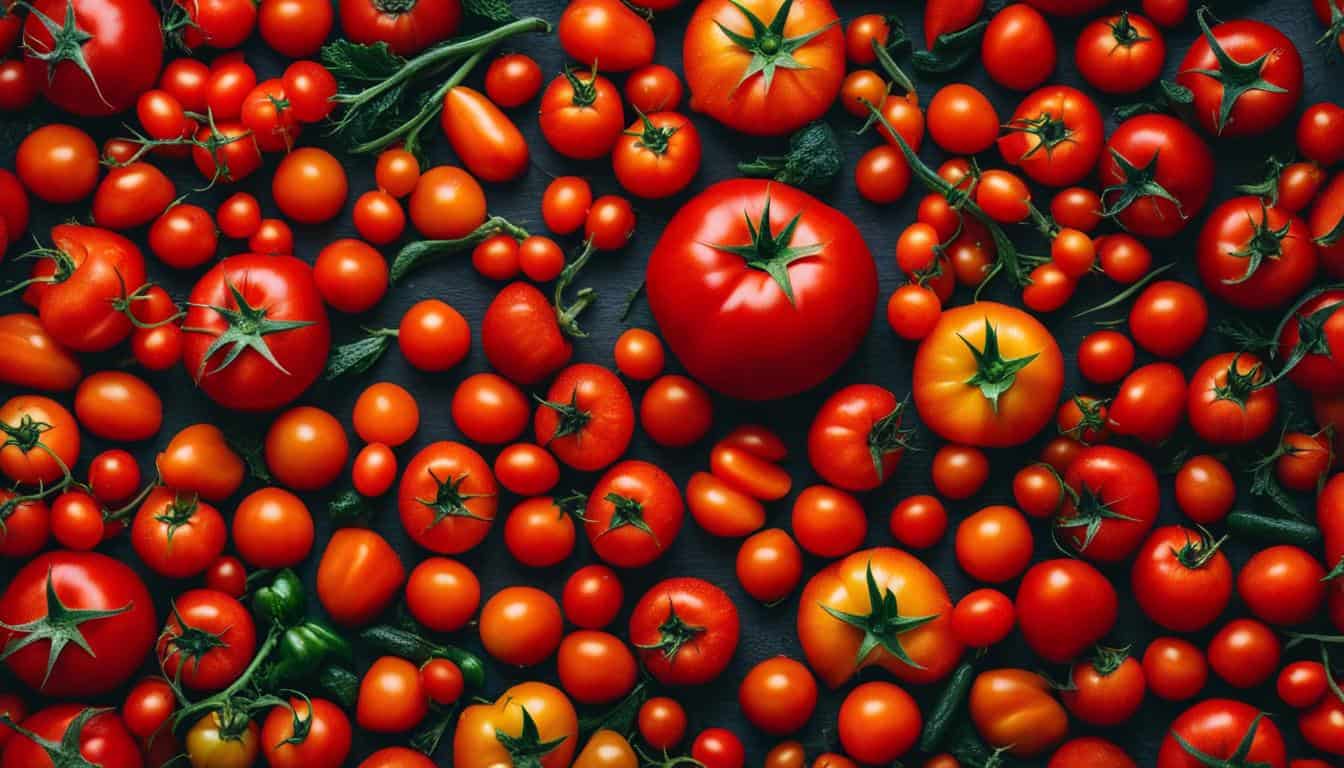Greetings! Today, I want to shed light on the fascinating debate surrounding tomatoes — are they classified as a fruit or a vegetable? Many of us have grown up believing them to be vegetables, but the truth might surprise you. Let’s dive in and discover the real nature of tomatoes.
Tomatoes, also known as tomato fruit, are much more than just a flavorful addition to our meals. They are rich in natural vitamins and minerals, including vitamin A, K, B1, and C, as well as folate, iron, potassium, magnesium, zinc, and phosphorus. These nutrients contribute to the numerous health benefits they offer, making them an essential part of a balanced diet.
Key Takeaways:
- Tomatoes are classified as fruits botanically, as they are formed from flowers and contain seeds.
- Despite their botanical classification, tomatoes are often referred to as vegetables in the culinary world and legal contexts.
- Tomatoes are packed with nutritional value, containing vitamins, minerals, and antioxidants.
- They offer various health benefits, including boosting the immune system, promoting heart health, and reducing the risk of certain cancers.
- Tomatoes are incredibly versatile and used in a wide range of culinary preparations, from salads to sauces.
The Botanical Classification of Tomatoes
When it comes to the classification of tomatoes, there is often confusion and debate. Botanically speaking, tomatoes are classified as fruits. This classification is based on the scientific definition of fruits, which are formed from flowers and contain seeds. Tomatoes fit this description perfectly, as they are formed from yellow flowers and contain multiple seeds. In fact, each of those seeds has the potential to grow into a new tomato plant, further solidifying their botanical classification as fruits.
However, despite their botanical classification, tomatoes are often referred to and used as vegetables in culinary practices. This disparity between botanical and culinary classifications has led to ongoing discussions and misconceptions about whether tomatoes should be classified as fruits or vegetables.
Botanical Classification of Tomatoes
According to botany, tomatoes are classified as fruits. Fruits are formed from flowers, contain seeds, and are part of the plant’s reproductive process. In the case of tomatoes, they are formed from yellow flowers and have multiple seeds, making them true botanical fruits.
Culinary Classification of Tomatoes
In culinary contexts and everyday language, however, tomatoes are often considered and referred to as vegetables. This is primarily based on their common use in savory dishes and their lack of the typical sweetness associated with fruits. For culinary purposes, tomatoes are classified as vegetables due to their flavor profile and how they are used in various dishes.
So, while tomatoes may be classified as fruits from a botanical perspective, they are frequently treated and thought of as vegetables in culinary practices.
Despite the debate and confusion surrounding the classification of tomatoes, what truly matters is their versatility, nutritional value, and delicious taste. Whether you consider them fruits or vegetables, there’s no denying the culinary wonders and health benefits that tomatoes bring to our plates.
Culinary Classification of Tomatoes
In culinary practice, fruits and vegetables are differentiated primarily based on their flavor. Fruits typically have a sweet pulp, a soft texture, and are used in desserts, smoothies, and jams, or eaten directly as a sweet snack. On the other hand, vegetables have a bitter taste and a tougher texture, which makes them more suitable for dishes like stir-fries and salads.
Although tomatoes are classified as fruits botanically, they are often used as vegetables in culinary preparations.
To understand the culinary classification of tomatoes, it’s important to consider their flavor profile and how they are commonly used in cooking. While tomatoes possess some sweetness, they also exhibit a mild acidity, which sets them apart from typical fruits. This acidic quality gives tomatoes a unique and versatile culinary appeal.
Tomatoes add a burst of tangy flavor to savory dishes and pair well with a wide range of ingredients. They are used in various culinary preparations, including salads, sandwiches, pasta sauces, and salsas. The bright red color and juicy texture of tomatoes enhance the visual appeal and overall taste of these dishes. Whether it’s a classic Caprese salad, a hearty spaghetti Bolognese, or a zesty tomato salsa, tomatoes bring a satisfying depth of flavor to the table.
Let’s explore some popular culinary uses of tomatoes:
- In salads: Tomatoes are a staple ingredient in refreshing salads. They add a juicy and tangy element to leafy greens, cucumber, and other vegetables, creating a delightful burst of flavors.
- In sauces and soups: Tomatoes are renowned for their role in creating rich and flavorful sauces, such as marinara and tomato-based curries. They form the base of classic dishes like spaghetti sauce and tomato soup, providing a savory foundation.
- In sandwiches and burgers: Sliced tomatoes are a common addition to sandwiches and burgers, offering a fresh and juicy component that complements the other ingredients.
- In salsas and dips: Tomatoes are the main ingredient in popular dips and salsas, adding a vibrant color and tangy taste. From chunky tomato salsa to creamy tomato-based dips, they elevate the overall flavor profile.
Culinary Classification of Tomatoes
In culinary practice, fruits and vegetables are differentiated primarily based on their flavor. Fruits typically have a sweet pulp, a soft texture, and are used in desserts, smoothies, and jams, or eaten directly as a sweet snack. On the other hand, vegetables have a bitter taste and a tougher texture, which makes them more suitable for dishes like stir-fries and salads.
Although tomatoes are classified as fruits botanically, they are often used as vegetables in culinary preparations.
To understand the culinary classification of tomatoes, it’s important to consider their flavor profile and how they are commonly used in cooking. While tomatoes possess some sweetness, they also exhibit a mild acidity, which sets them apart from typical fruits. This acidic quality gives tomatoes a unique and versatile culinary appeal.
Tomatoes add a burst of tangy flavor to savory dishes and pair well with a wide range of ingredients. They are used in various culinary preparations, including salads, sandwiches, pasta sauces, and salsas. The bright red color and juicy texture of tomatoes enhance the visual appeal and overall taste of these dishes. Whether it’s a classic Caprese salad, a hearty spaghetti Bolognese, or a zesty tomato salsa, tomatoes bring a satisfying depth of flavor to the table.
Let’s explore some popular culinary uses of tomatoes:
- In salads: Tomatoes are a staple ingredient in refreshing salads. They add a juicy and tangy element to leafy greens, cucumber, and other vegetables, creating a delightful burst of flavors.
- In sauces and soups: Tomatoes are renowned for their role in creating rich and flavorful sauces, such as marinara and tomato-based curries. They form the base of classic dishes like spaghetti sauce and tomato soup, providing a savory foundation.
- In sandwiches and burgers: Sliced tomatoes are a common addition to sandwiches and burgers, offering a fresh and juicy component that complements the other ingredients.
- In salsas and dips: Tomatoes are the main ingredient in popular dips and salsas, adding a vibrant color and tangy taste. From chunky tomato salsa to creamy tomato-based dips, they elevate the overall flavor profile.
The Historical Misconceptions about Tomatoes
In the past, tomatoes were surrounded by misconceptions and confusion. In England, they were initially considered ornamental plants, and people were told that the fruit was poisonous. This belief might have stemmed from the fact that the acid from tomatoes leached lead out of pewter plates, causing illnesses. However, historical figures like Thomas Jefferson helped dispel these misconceptions by using tomatoes in various dishes, including tomato paste and ketchup. Nevertheless, as late as 1820, some people still believed that raw tomatoes were poisonous.

| Historical Misconceptions about Tomatoes | Clarification |
|---|---|
| Tomatoes were considered ornamental plants in England. | This misconception arose due to the initial unfamiliarity with tomatoes and their purpose. |
| People believed that tomatoes were poisonous. | This misconception likely originated from the association of tomatoes with lead poisoning caused by acidic foods interacting with pewter plates. |
| Thomas Jefferson used tomatoes in his dishes. | Jefferson’s culinary use of tomatoes showcased their safety and contributed to dispelling the misconception. |
| Some individuals believed that raw tomatoes were poisonous as late as 1820. | Despite evidence to the contrary, lingering misconceptions persisted, reinforcing the belief that tomatoes were harmful to consume. |
“Tomatoes are not poisonous, nor are they harmful. In fact, they are incredibly versatile and packed with nutritional benefits.” – Thomas Jefferson
The Case of Nix v. Hedden
The legal case of Nix v. Hedden played a significant role in the classification of tomatoes in the United States. This case brought the debate over whether tomatoes should be considered as fruits or vegetables to the highest court in the country. Interestingly, the decision made in this case disregarded the botanical definition of fruits and vegetables and instead focused on the common language and understanding of the people.
In the common language, tomatoes are commonly thought of and referred to as vegetables, irrespective of their botanical classification as fruits.
This legal precedent, established by the Supreme Court, highlighted the importance of common language and everyday understanding in classifying tomatoes. It emphasized that the way people perceive and use tomatoes in their daily lives is more relevant than the dictionary definitions or botanical classifications.
Although tomatoes are botanically classified as fruits due to their formation from flowers and possession of seeds, they are widely recognized as vegetables in culinary and legal contexts.

Legal Precedent: Common Language and Classification
The decision made in the Nix v. Hedden case had a lasting impact on the classification of tomatoes and demonstrated the significance of common language. It set the precedent that tomatoes should be considered as vegetables in everyday conversation and legal dialogues, despite their botanical classification as fruits.
| Botanical Classification | Culinary and Legal Classification |
|---|---|
| Fruit | Vegetable |
| Formed from flowers | Used in savory dishes |
| Contains seeds | Often cooked or consumed raw in salads |
This table compares the botanical classification of tomatoes as fruits with their culinary and legal classification as vegetables. It illustrates the distinctions between these two perspectives and reinforces the idea that context and common language play a significant role in how tomatoes are classified.
Despite the ongoing debate and confusion surrounding the classification of tomatoes, one thing remains clear: tomatoes are incredibly versatile and widely enjoyed, whether considered as fruits or vegetables.
The Aztec Connection and Tomato Varieties
In the fascinating history of tomatoes, their roots can be traced back to the Aztecs. These vibrant fruits were a common and essential part of the Aztec diet, offering a burst of flavor and nutrition. When the conquistadors arrived in the New World, they encountered tomatoes for the first time and brought them back to Spain. From there, tomatoes found their way to Italy, where they took center stage in beloved dishes like spaghetti with tomato sauce.
“Tomatoes have a rich culinary heritage, from their humble beginnings in the Aztec civilization to their transformation into a beloved ingredient in Italian cuisine,” says renowned chef and tomato enthusiast, Mario Batali.
Today, the world of tomatoes is incredibly diverse, with over 25,000 recognized varieties. Each variety brings its own unique flavor, color, and texture to the table. From juicy slicing tomatoes perfect for sandwiches to sweet cherry tomatoes that add a burst of freshness to salads, and robust sauce tomatoes perfect for canning, there is a tomato variety to suit every taste and culinary need.
Nutritional Value and Health Benefits of Tomatoes
Tomatoes are not only a flavorful addition to our meals but also a powerhouse of essential nutrients. They are a rich source of vitamins A, K, B1, and C. These vitamins play a crucial role in supporting our overall health and well-being. Vitamin A promotes good vision and a healthy immune system, while vitamin K is essential for blood clotting and maintaining bone health. Vitamin B1, also known as thiamine, helps convert food into energy, and vitamin C boosts our immune system and promotes the growth and repair of tissues.
Aside from vitamins, tomatoes also contain an array of minerals that are important for optimal bodily functions. These minerals include iron, which is vital for carrying oxygen in our blood; potassium, which helps maintain healthy blood pressure levels; magnesium, which is essential for muscle and nerve function; zinc, which supports our immune system and aids in wound healing; and phosphorus, which is necessary for healthy bones and teeth.
These nutrients contribute to the overall nutritional value of tomatoes and offer a wide range of health benefits. Let’s explore some of the key advantages:
- Boosts the immune system: The high vitamin C content in tomatoes helps strengthen our immune system, making it more resilient against infections and diseases.
- Promotes heart health: Potassium and vitamin B1 in tomatoes work together to support a healthy heart by maintaining proper blood pressure levels and improving heart function.
- Reduces the risk of certain cancers: Tomatoes contain potent antioxidants, such as lycopene, which has been linked to a reduced risk of prostate, lung, and stomach cancers.
- Aids in digestion: The fiber content in tomatoes promotes healthy digestion and helps prevent constipation.
- Supports eye health: Tomatoes are rich in vitamin A and other antioxidants, which play a crucial role in maintaining good vision and reducing the risk of eye diseases like macular degeneration.
With their impressive nutritional profile and numerous health benefits, tomatoes are a fantastic addition to any balanced diet. Whether enjoyed raw, cooked, or in various culinary preparations, these vibrant fruits provide us with essential vitamins, minerals, and antioxidants that support our well-being.
| Nutrient | Nutritional Value per 100g |
|---|---|
| Calories | 18 kcal |
| Protein | 0.9 g |
| Carbohydrates | 3.9 g |
| Fat | 0.2 g |
| Vitamin A | 42% of the Daily Value (DV) |
| Vitamin C | 14% of the DV |
| Potassium | 237 mg |
| Lycopene | 2573 µg |
Note: The nutritional values provided are approximate and may vary depending on the specific tomato variety.

Culinary Uses of Tomatoes
Tomatoes are incredibly versatile in the culinary world. They can be incorporated into a wide range of dishes, adding a burst of flavor and vibrant color. Whether you’re making a refreshing salad, a hearty curry, a comforting soup, a tangy sauce, or a zesty salsa, tomatoes are an essential ingredient.
Salads: Tomatoes are a staple in salads, bringing a juicy texture and a refreshing taste. They pair well with other vegetables like cucumbers, lettuce, and bell peppers to create a colorful and nutritious salad.
Curries: Tomatoes are often used as a base in Indian curries, providing a tangy and slightly sweet flavor. They help create rich and aromatic gravies that complement a variety of meats, vegetables, and spices.
Soups: Tomato soup is a classic favorite, loved for its comforting and rich taste. Tomatoes lend their natural sweetness to the soup, creating a smooth and creamy texture. It can be enjoyed on its own or paired with grilled cheese for a satisfying meal.
Sauces: Tomatoes are the star ingredient in many pasta sauces, such as marinara and Bolognese. They add depth, acidity, and a hint of sweetness to the sauce. Simmering the tomatoes with herbs and spices enhances their flavor, creating a delectable sauce that coats pasta perfectly.
Salsas: Fresh tomato salsas are vibrant, zesty, and bursting with flavor. They are commonly served with tortilla chips or used as a topping for tacos, burritos, and grilled meats. Tomatoes, along with onions, cilantro, lime juice, and various spices, create a refreshing salsa that adds a burst of freshness to any dish.
Tomatoes can be enjoyed both cooked and raw, depending on the desired texture and flavor profile. The cooking process deepens their flavor, while raw tomatoes offer a crisp and juicy bite. However you choose to use them, tomatoes are sure to elevate your culinary creations.

Tomato Myths and Common Misconceptions
Despite being a beloved ingredient in kitchens around the world, tomatoes often find themselves surrounded by myths and misconceptions. Let’s address some of the most common beliefs:
- Tomatoes are harmful due to their acidity: This is a widespread misconception. While tomatoes do have a slightly acidic taste, they pose no significant health risks. In fact, the acidity in tomatoes can aid in digestion and provide a burst of flavor in various dishes.
- Tomatoes are not suitable for individuals with certain health conditions: It is a prevailing belief that tomatoes, especially in their raw form, should be avoided by individuals with conditions like arthritis. However, there is no scientific evidence to support this claim. On the contrary, tomatoes have anti-inflammatory properties and are considered beneficial for overall health.
In reality, tomatoes are a nutritious and wholesome addition to a balanced diet. They offer a range of health benefits and can be safely consumed by most people. Let’s dispel these misconceptions and appreciate the facts about tomatoes.
The Nutritional Value of Tomatoes
Tomatoes are not only delicious but also packed with essential nutrients. Here’s a glimpse of their nutritional profile:
| Nutrient | Amount per 100g |
|---|---|
| Vitamin C | 23.4 mg |
| Vitamin A | 833 IU |
| Potassium | 237 mg |
| Fiber | 1.2 g |
| Lycopene | 2573 µg |
These nutrients contribute to the overall health benefits of tomatoes. For example, vitamin C boosts the immune system, while lycopene acts as a powerful antioxidant that helps reduce the risk of certain cancers. With their low-calorie count and high water content, tomatoes are a guilt-free and hydrating addition to any meal.
So, next time you enjoy a juicy tomato in a refreshing salad or savory pasta dish, remember that you’re not only savoring its delicious flavor but also nourishing your body with a host of beneficial nutrients.
Remember, the acidity of tomatoes poses no health risks, and they can be safely consumed by most individuals. Embrace the plethora of nutritional benefits they offer and enjoy them as a part of your healthy lifestyle.

Tomatoes are indeed not just an everyday ingredient but a powerhouse of flavor and nutrition. Don’t let misconceptions hinder your enjoyment of these vibrant fruits. Embrace the truth, experience the delightful taste, and relish the incredible health benefits they bring to your plate.
Tomato: A Fruit or Vegetable?
The classification of tomatoes can be quite perplexing. Botanically speaking, tomatoes are fruits. They are formed from flowers and contain seeds, which aligns with the scientific definition of a fruit. However, when it comes to culinary terms and legal contexts, tomatoes are often referred to as vegetables.
It’s important to understand that the classification of fruits and vegetables can vary depending on different perspectives and definitions. In everyday language, fruits are typically associated with sweetness and are used in desserts, smoothies, and jams. On the other hand, vegetables tend to have a more savory taste and are commonly used in dishes like stir-fries and salads.
Despite the botanical classification, tomatoes are often considered vegetables in culinary practice due to their predominant use in savory preparations. Their versatility and ability to add flavor and color to various dishes have solidified their place in the vegetable category of culinary classification.
While the scientific classification may label tomatoes as fruits, the culinary and legal viewpoint often leans towards categorizing them as vegetables. This divergence of opinion reveals the interplay between botany and everyday language in defining the nature of tomatoes.
Regardless of the classification, tomatoes remain a staple in many kitchens around the world. Their rich nutritional profile, including vitamins A, K, B1, and C, as well as minerals like iron, potassium, and magnesium, makes them a valuable addition to any diet. Whether you consider them a fruit or a vegetable, tomatoes continue to be enjoyed in a wide array of culinary creations.
Conclusion
In conclusion, tomatoes are scientifically classified as fruits due to their botanical characteristics. They are formed from flowers and contain seeds, which aligns with the definition of fruits in botany. However, in culinary and legal contexts, tomatoes are commonly referred to as vegetables. This discrepancy in classification has caused historical misconceptions and ongoing confusion among people about whether tomatoes are fruits or vegetables.
Despite the debate surrounding their classification, tomatoes undeniably offer numerous health benefits and culinary versatility. They are packed with essential vitamins, minerals, and antioxidants, contributing to their nutritional value. Tomatoes are known for boosting the immune system, promoting heart health, and reducing the risk of certain diseases. Moreover, they can be enjoyed in various culinary preparations, including salads, sauces, soups, and salsas, adding flavor, texture, and visual appeal to dishes.
Throughout history, misconceptions about tomatoes have prevailed, with some believing that they are harmful or not suitable for certain individuals. However, these misconceptions have been debunked. Tomatoes pose no significant health risks for most people and can be safely consumed as part of a balanced diet. It is crucial to educate and spread awareness about the true nature of tomatoes to dispel these misconceptions.
In essence, whether you consider tomatoes as fruits or vegetables, their incredible nutritional value, culinary versatility, and debunked misconceptions make them a beloved and essential ingredient in various cuisines worldwide. So the next time you enjoy a delicious tomato salad or savor a tangy tomato sauce, remember the fascinating debate that surrounds this incredible fruit-vegetable hybrid.
FAQ
Why is tomato classified as a fruit?
Tomatoes are botanically classified as fruits because they are formed from flowers and contain seeds, which are key characteristics of fruits in the plant’s reproductive process.
How are tomatoes classified in culinary terms?
In culinary terms, tomatoes are often considered vegetables because of their common use in savory dishes like salads, curries, soups, and sauces.
What are some historical misconceptions about tomatoes?
In the past, there were misconceptions that tomatoes were poisonous or only meant for ornamental use. These beliefs were debunked over time as tomatoes gained popularity in various culinary preparations.
What is the significance of the legal case Nix v. Hedden regarding tomato classification?
The case established that, in a legal context, tomatoes are considered vegetables based on common language and usage, regardless of their botanic classification as fruits.
What is the connection between the Aztec diet and tomato varieties?
Tomatoes were a common part of the Aztec diet, and they were brought back to Spain by conquistadors. From there, tomato plants spread to different parts of the world, leading to the development of various tomato varieties.
What is the nutritional value of tomatoes and their health benefits?
Tomatoes are rich in vitamins A, K, B1, and C, as well as minerals like iron, potassium, magnesium, zinc, and phosphorus. They provide various health benefits, including boosting the immune system, promoting heart health, and reducing the risk of certain cancers.
How are tomatoes used in culinary preparations?
Tomatoes are incredibly versatile and can be used in a wide range of dishes such as salads, curries, soups, sauces, and salsas. They add flavor and vibrant color to these preparations, enhancing the overall taste and visual appeal.
What are some common myths and misconceptions about tomatoes?
Some misconceptions include the belief that tomatoes are harmful due to their acidity or that they are unsuitable for individuals with certain health conditions like arthritis. However, tomatoes pose no significant health risks and can be safely consumed by most people as part of a balanced diet.
Is a tomato a fruit or a vegetable?
Botanically, tomatoes are classified as fruits due to their formation from flowers and containing seeds. However, in culinary and legal contexts, they are often referred to as vegetables, emphasizing the different perspectives and definitions used in botany and everyday language.
Source Links
- https://www.gothenburgleader.com/news/columns/a-little-history-of-the-tomato-fruit/article_ce31ac64-6878-11ee-8492-733acbcdabe1.html
- https://timesofindia.indiatimes.com/life-style/food-news/is-tomato-fruit-or-vegetable/articleshow/69972858.cms
- https://www.grunge.com/755541/the-truth-about-the-supreme-court-case-that-declared-tomatoes-vegetables/





Leave a Reply